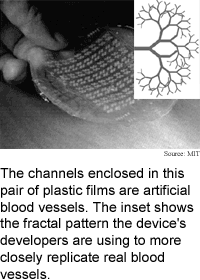

Fractals support
growing organs
VR accommodates reality
Fractals support growing organs
Eyes off, screen off
Chip senses trace DNA
News briefs:
Laser bursts pierce fog
Electricity loosens tiny bits
Nano light stores data in polymer
See-through magnets hang tough
Munching microbes feed fuel cell
Crystal cracks nurture nanowires

Today scientists can regenerate tissue
such as skin, but they are still figuring out how to grow replacement
organs. The challenge is in coaxing cells from organs to grow into new
organs rather than unstructured clusters of cells.
Researchers from Harvard Medical School,
Massachusetts General Hospital and the Massachusetts Institute of
Technology have found a way to impart structure to growing cells that may
eventually allow for growth of entire organs.
If the method proves successful, "we can use [a]
patient's own cells to create a living organ and this will remove the
problems with organ rejections" and a shortage of donor organs, said
Mohammed Kaazempur-Mofrad, a researcher at MIT and a senior research
fellow at Harvard Medical School and Massachusetts General Hospital. This
ultimate goal is still far away, he added.
Key
to the method is supporting the growing cells with something akin to the
circulatory system, which provides cells with oxygen and nutrients. "In
order to make living replacements for large vital organs such as the liver
and kidney, it is essential to integrate the creation of vasculature with
the tissue engineering," said Kaazempur-Mofrad. And the growth of these
vascular networks has to be highly controlled and precise, he said.
The researchers used computer-generated fractal
patterns to fabricate a network of branching, microscopic tubes. Fractals
are patterns that repeat at different scales. If, for instance, one
portion of a fractal looks like a tree, zooming in on its branches and
twigs will show that they also look like trees, and zooming further will
show that their branches and twigs follow the same pattern.
These self-similar patterns are common in nature,
including natural blood vessel networks, and can scale up or down in size.
"Using [the] fractal concept will make it easier to mimic... nature and
also to scale up our designs from one animal to another," said
Kaazempur-Mofrad.
The researchers used
computer chip manufacturing techniques to precisely etch the patterns onto
silicon wafers to form a mold. "Microfabrication... provides a platform to
generate such vascular networks with submicron, exquisite precision,"
Kaazempur-Mofrad said.
They used the patterned
wafers to make microfluidic channels from biodegradable, biocompatible
polymers, then stacked the networks to form a three-dimensional framework
for growing cells.
The researchers'
experiments using the prototypes showed that the frameworks can supply
oxygen and nutrients to human kidney and liver cells. Ninety-six percent
of the kidney cells were viable at the end of a one-week experiment and
and 95 percent of the liver cells were viable at the close of a two-week
experiment.
The work spans many disciplines --
it "brings together mechanical engineering, microfabrication, materials
science and polymer processing, biotechnology, biology, and medicine,"
said Kaazempur-Mofrad.
The researchers are
aiming to evaluate and characterize the method in animals within five
years, said Kaazempur-Mofrad.
Kaazempur-Mofrad's research colleagues were Jeffrey
T. Borenstein from Charles Stark Draper Laboratory, Wing S. Cheung, Lauren
M. Hartman, Michael Y. Shin, and Joseph P. Vacanti of Harvard Medical
School and Massachusetts General Hospital and Eli J. Weinberg of the
Massachusetts Institute of Technology (MIT) and Charles Stark Draper
Laboratory. They presented the research at the American Society for
Microbiology (ASM) Conference on Bio-, Micro-, Nanosystems build in New
York City on July 7 to 10. The research was funded by MIT and the Defense
Advanced Research Projects Agency (DARPA).
Timeline: 5 years
Funding:
Government, University
TRN Categories: Biotech;
Materials Science and Engineering; Applied Technology
Story
Type: News
Related Elements: Technical paper,
"Microfabricated Microfluidic Biodegradable Systems for Vascularized
Tissue Engineering of Vital Organs: Design, Modeling and Functional
Testing," American Society for Microbiology (ASM) conference on Bio-,
Micro-, Nanosystems, July 7-10, New York City.
Offline Editions and Reports TRN Store Feedback Letters Comments About TRN
Find out about TRN Services for Web sites and print publications.
© Copyright Technology Research News, LLC 2000-2003. All rights reserved.